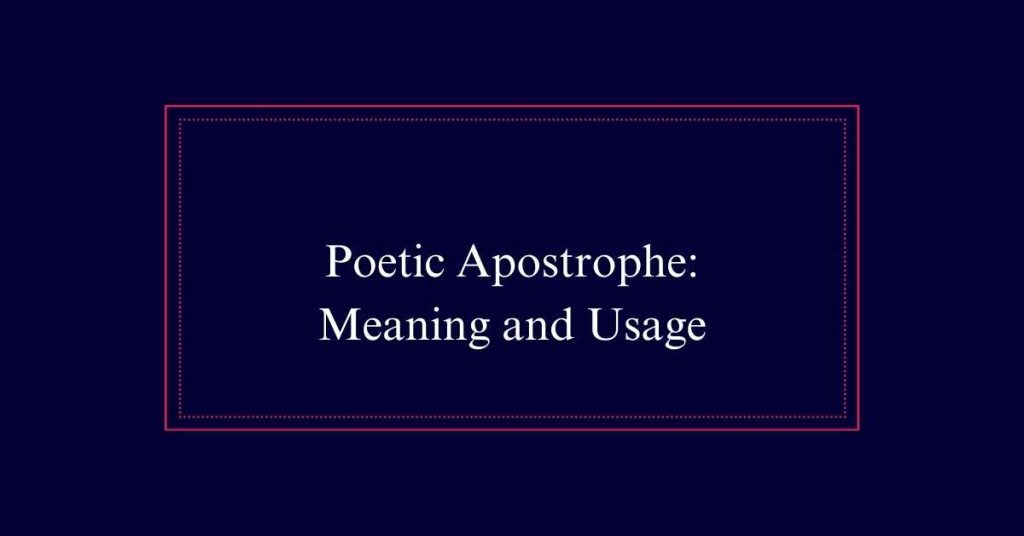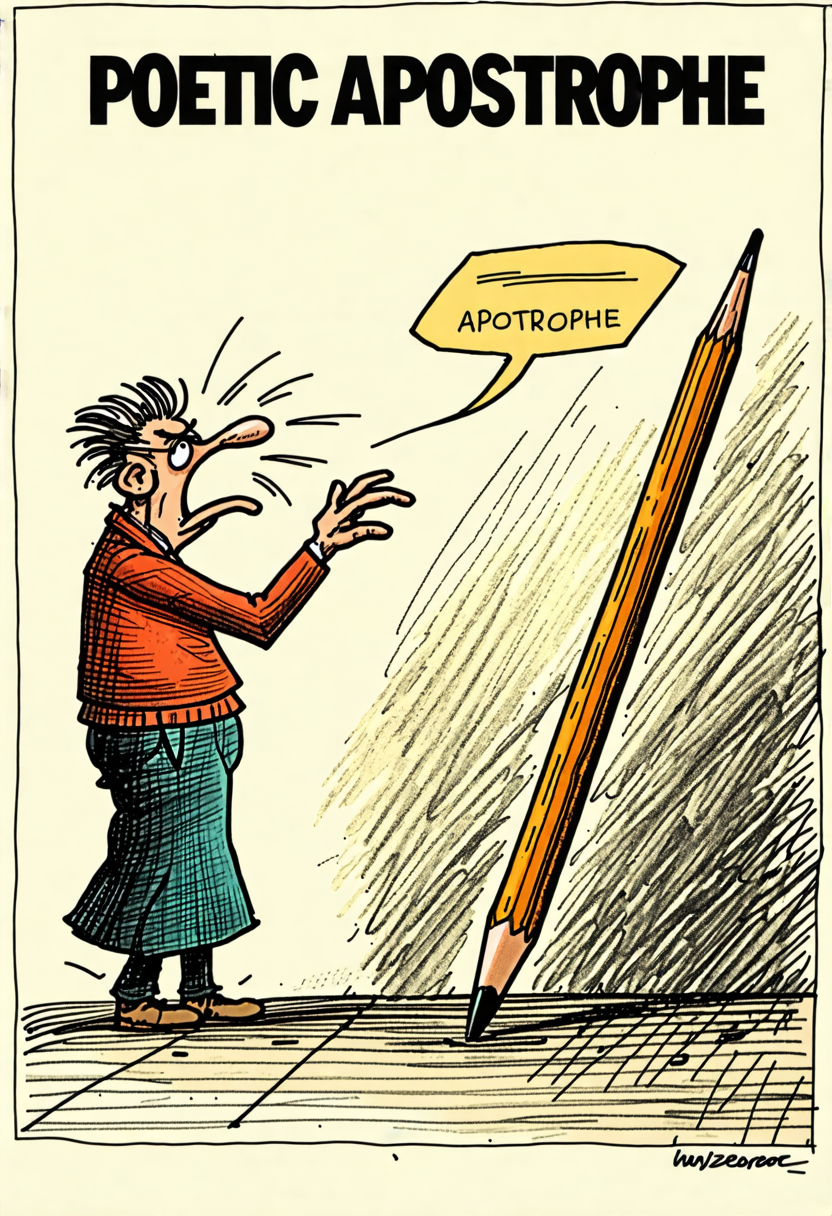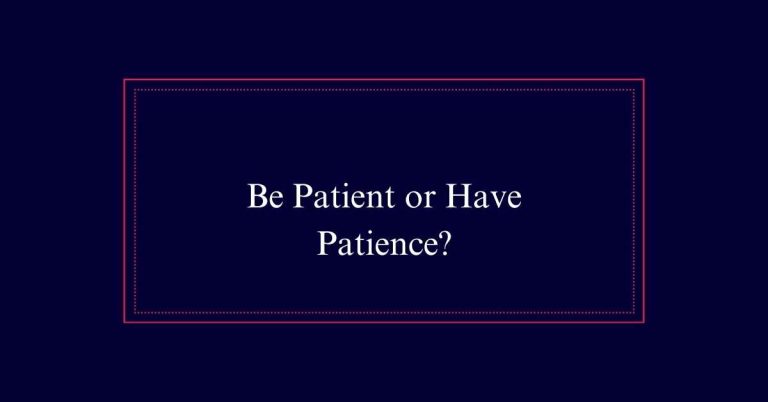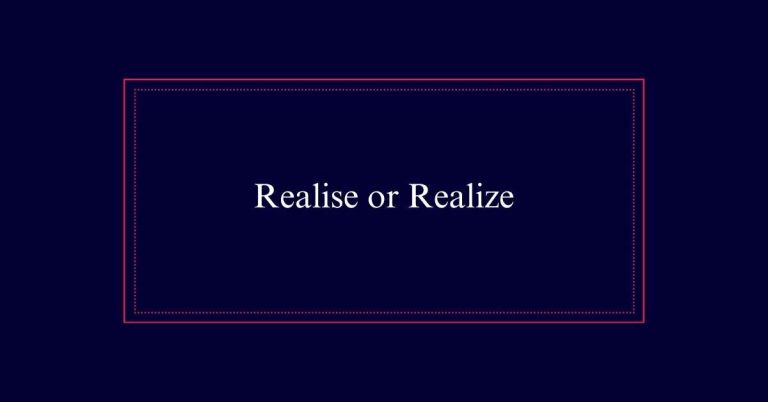Poetic Apostrophe: Meaning and Usage
Poetic apostrophe is a literary device where the speaker addresses absent persons, abstract ideas, or inanimate objects. This technique originated from Greek literature and evolved through Roman poetry and into the works of Renaissance and Romantic poets. It creates a direct emotional connection, often starting with “O” for a formal tone, personifying non-living entities.
Common themes include love, death, nature, and time, invoking profound emotional responses. Notable poets like Wordsworth, Shakespeare, and Plath have used apostrophe to explore deep emotions and universal experiences.
Definition of Poetic Apostrophe
Poetic apostrophe is a literary device where the speaker addresses an absent person, an abstract idea, or an inanimate object. This technique allows poets to speak directly to entities that cannot respond.
It often begins with the interjection ‘O,’ creating an immediate sense of addressing something or someone important. For example, in Christopher Marlowe’s ‘Edward II,’ Queen Isabelle speaks to death as if it were present.
This approach brings abstract concepts and lifeless objects to the forefront, giving them human-like qualities. By using apostrophe, poets can convey strong emotions and highlight the significance of their subjects.
Origins of Apostrophe
The term ‘apostrophe’ originates from the Greek word ‘apostrophé,’ meaning ‘turning away.’ This literary device allows poets to address an absent person, abstract idea, or inanimate object as if it were present. The roots of apostrophe lie in classical Greek literature, where it was used to create a direct and emotional connection between the speaker and the subject.
| Aspect | Description |
|---|---|
| Origin | Greek word ‘apostrophé’ |
| Literal Meaning | Turning away |
| Purpose | Addressing an absent or abstract entity |
| Early Use | Classical Greek literature |
| Emotional Impact | Creates a direct, emotional connection |
Historical Usage in Poetry
Building on its classical Greek origins, the use of apostrophe in poetry has evolved greatly throughout history. In ancient Greek literature, poets used apostrophe to address gods, muses, and abstract ideas directly. This tradition carried into Roman poetry, where writers like Virgil and Ovid employed the device.
During the Renaissance, poets such as Shakespeare and Marlowe used apostrophe to evoke strong emotions and highlight significant themes. The Romantic poets, including Wordsworth and Keats, further popularized the use of apostrophe, often addressing nature and emotions.
Even in modern poetry, apostrophe remains a powerful tool for poets. It allows them to create intimacy with their subjects, whether they are addressing love, death, or even inanimate objects.
Key Characteristics
Frequently, the use of apostrophe in poetry serves to create a direct and emotional connection between the speaker and an absent entity. This literary device allows poets to address abstract concepts, inanimate objects, or deceased individuals as if they were present.
Apostrophe often begins with the interjection ‘O,’ lending an archaic or formal tone. It personifies non-living entities, imbuing them with human qualities. The device enhances the emotional intensity of the poem, making the reader feel the speaker’s strong emotions.
Apostrophe also underscores the importance of the addressed subject, highlighting its significance in the poem. Overall, this technique fosters a deep, personal engagement between the poet, the subject, and the audience.

Common Themes and Subjects
In poetic apostrophe, common themes often include love, death, nature, and time. These themes allow poets to explore deep emotions and universal experiences. They address subjects directly, creating a personal connection.
Here are some typical subjects in poetic apostrophe:
- Love: Poets often speak to absent lovers, expressing longing or admiration.
- Death: Addressing death personifies it, making it more relatable and profound.
- Nature: Poets might speak to elements like the wind or the stars, highlighting their beauty.
- Time: Engaging with time emphasizes its fleeting nature and impact on life.
Emotional Impact
Exploring themes such as love, death, nature, and time in poetic apostrophe allows poets to evoke profound emotional responses from their readers. By addressing abstract concepts like love or mortality directly, poets create a personal connection with their audience. This connection enhances the emotional impact of the poem, making the reader feel the intensity of the emotions being expressed.
Here is a table summarizing some emotional impacts:
| Theme | Emotional Impact | Example Response |
|---|---|---|
| Love | Deep affection | Warmth, nostalgia |
| Death | Sorrow and reflection | Sadness, contemplation |
| Nature | Awe and tranquility | Peace, admiration |
Examples From Classic Literature
Classic literature offers numerous examples of poetic apostrophe, demonstrating its enduring power and versatility. This literary device allows poets to address abstract concepts, inanimate objects, or absent individuals, creating a direct and emotional connection.
Here are four notable examples from classic literature:
- John Milton’s ‘Paradise Lost’: Milton addresses ‘Light’ in an emotional plea, personifying it as a powerful and almost divine entity.
- William Wordsworth’s ‘Ode: Intimations of Immortality’: Wordsworth speaks to ‘Childhood,’ imbuing it with a sense of lost innocence and wonder.
- Percy Bysshe Shelley’s ‘Ode to the West Wind’: Shelley speaks directly to the wind, invoking its strength and transformative power.
- William Shakespeare’s ‘Julius Caesar’: Mark Antony addresses Caesar’s corpse, stirring profound emotions and reflecting on themes of loyalty and betrayal.
Modern Usage in Poetry
While classic literature abounds with examples of poetic apostrophe, modern poets also harness this powerful device to evoke emotion and highlight significant themes.
Contemporary poets address not only traditional subjects like love and death but also more abstract concepts like time and technology. This technique allows them to personify these elements, making them relatable and vivid for readers.
Modern poetry often uses apostrophe to create an intimate connection between the speaker and the addressed entity. This method not only adds depth to the poem but also engages readers on a personal level.
Techniques for Writing Apostrophe
Mastering the technique of apostrophe in poetry involves directly addressing an absent or imaginary entity to evoke emotional depth. Here are some techniques to help:
- Choose Your Subject: Decide whether to address an abstract concept, inanimate object, or a person who is not present.
- Use Vivid Imagery: Paint a clear picture with words to make the entity feel real and present.
- Incorporate Emotion: Convey strong feelings to create a powerful connection between the speaker and the subject.
- Open with ‘O’: Start your address with the interjection ‘O’ to add a dramatic and formal tone.
Notable Poets and Works
Understanding the techniques of apostrophe is enhanced by studying notable poets and their works that exemplify this device. One prominent example is John Donne’s ‘Death, be not proud,’ where he directly addresses death as if it were a person.
Similarly, William Wordsworth’s ‘Ode to Duty’ uses apostrophe to speak to the abstract concept of duty. In ‘Ode to the West Wind,’ Percy Bysshe Shelley addresses the wind, invoking its power and presence.
These works showcase how apostrophe can personify abstract ideas or inanimate objects, creating intimacy and emotional depth. By analyzing these texts, readers can see how apostrophe brings a unique dimension to poetry, making abstract or absent entities vividly present.
Frequently Asked Questions
How Does Poetic Apostrophe Differ From Other Literary Devices?
Poetic apostrophe uniquely involves directly addressing an absent or non-living entity, creating a sense of presence and emotional intensity. Unlike other devices, it personifies abstract concepts or inanimate objects, engaging readers with dramatic, vivid dialogue.
Can Apostrophe Be Used in Prose or Just Poetry?
Apostrophe can indeed be used in prose, not just poetry. It serves the same purpose of addressing an absent or abstract entity, adding emotional depth and direct engagement with the subject.
What Are Some Challenges When Writing Apostrophe Poetry?
Challenges in writing apostrophe poetry include ensuring the absent party feels relevant, maintaining emotional intensity, and avoiding clichés. Writers must balance addressing abstract concepts with clarity, while also evoking strong, authentic emotions in their audience.
How Does Apostrophe Enhance the Reader’s Experience?
Apostrophe enhances the reader’s experience by creating a direct connection with abstract concepts or absent entities. This literary device imbues non-living subjects with emotional depth, making the poem more engaging and relatable for readers.







